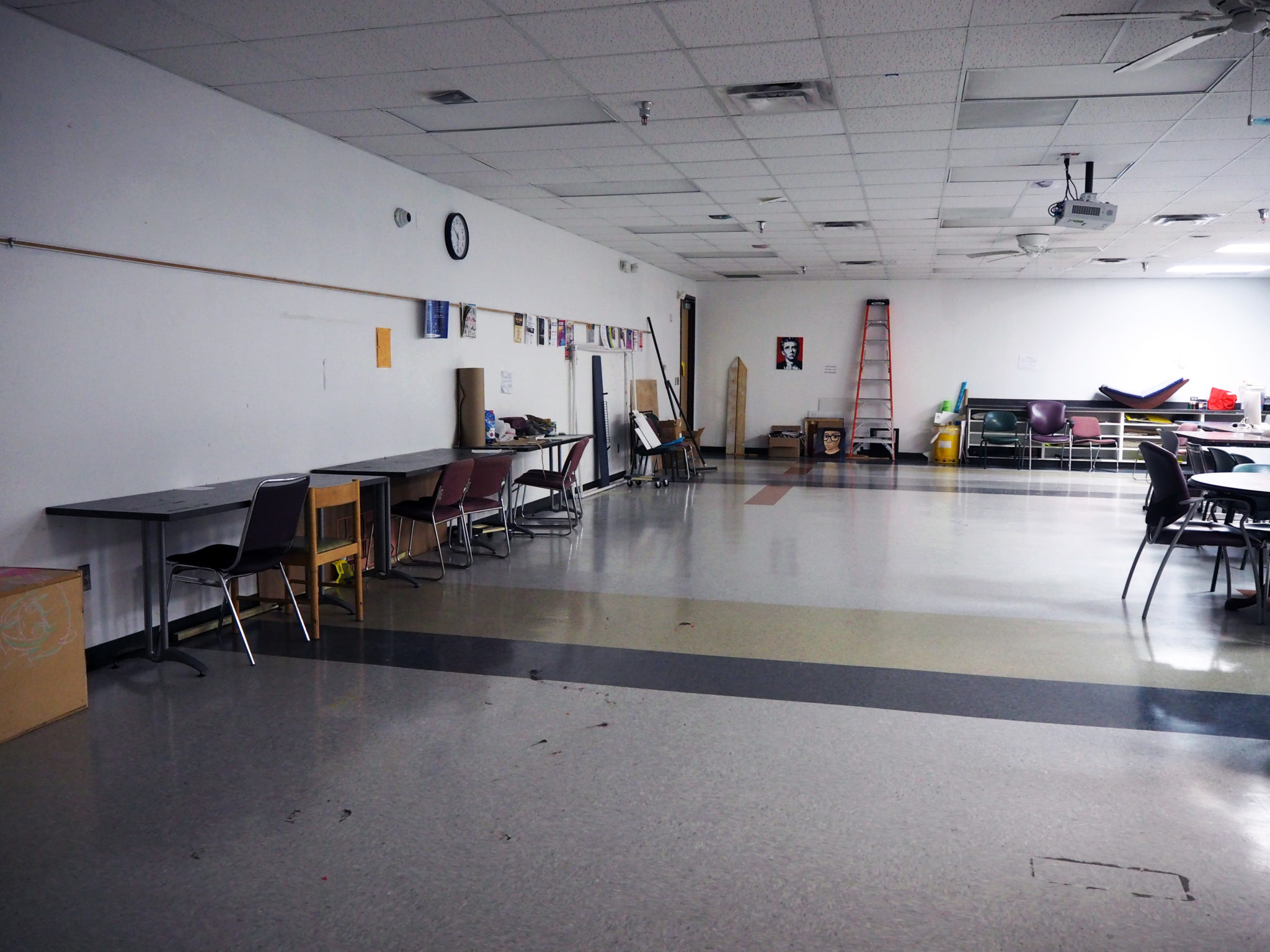
In the Visual Arts Building in Edinburg, UTRGV students use this space to work on their projects and eat. SYDNI D. SALINAS/THE RIDER
Students eat in the Visual Arts Building break room, while others stand on the opposite side of the room painting for an assignment they have due soon.
The paint smells like nothing, but all at the same time, an annoyance can be felt in the air that there isn’t enough room for these separate activities to take place comfortably.
This is the contradiction of the Visual Arts Building, formerly known as the Visual Arts Annex, located at 2412 S. Closner Blvd. in Edinburg.
It’s a creative space for students and professors who inspire great works of art, but there are issues that students say need to be addressed.
Interviewing students from the School of Art, the two main issues they have with the art annex are its sanitation and location.
Graphic design junior Stephanie Ramirez said that although the perk of being at the annex is good parking, being off campus limits the university experience.
“We miss out a lot on the events and the activities, and stuff like that. We don’t really know what’s going on over there,” Ramirez said.
Graphic design junior Lilly Chapa reiterated this sentiment by emphasizing her disappointment with her classes’ location.
“When I found out all my classes were [in the building], I was like, ‘Oh. OK,’” Chapa said.
She also said students need more equipment, such as Wacom tablets.
Ramirez and Chapa aren’t the only students who are disappointed by the building’s location.
Studio art juniors Kristen Sanchez and Jose Suarez, as well as graphic design junior Javier Gonzalez, detailed their issues with the building’s location and sanitation problem.
However, Sanchez’s problem goes beyond location, saying the building itself is a major complication for art students.
“The general building, it’s not fully equipped for the necessary needs of an art school,” she said.
Suarez agreed with Sanchez, saying the lack of room creates confining space.
“I just feel like it’s so cluttered,” Suarez said.
Gonzalez’s complaint is about the location.
“I feel like it’s a little too isolated, off to the side. … I think it’s too much separation,” he said.
Art Lecturer Erika M. Balogh said she enjoys being off campus.
“Spending several years here, I really enjoy that. … Parking is much easier here. I don’t feel separated,” Balogh said.
Her only complaints are the sanitation of the building and the need for more graphic design professors due to the majority of art students majoring in the field.
In regard to the need for a cleaner environment, Balogh said oftentimes her students end up having to clean inside the lab because of the dust lying about.
“All of our labs, I would say, our students every week start with cleaning our desks,” she said. “I think every week somebody should clean that, and not the students.”
Despite these concerns, she said, “I think if the classes are good, and they’re learning effectively, that makes them happy.”
In theory, that is good for students who have professors in their fields of concentration, but what about the graphic design students who need more classes and professors in their major?
Chapa echoed Balogh’s concern.
“More professors for graphic design,” Chapa said when asked what her highest concern is with the school.
There seems to be a culture growing from the seclusion of the art students, and an outcry for a closer and included presence on the Edinburg campus.
College of Fine Arts Dean Steven Block responded to the issue of location by stating that although a separate building for all of fine arts to be located altogether would be practical, this sort of change takes time.
“I think it would be better. The model that I would love to see would be a fine arts location in which all of the College of Fine Arts is in one central location, rather than spread out in several buildings all across campus,” Block said. “Now that would involve a new building, and, I think, the university right now, their priorities are understandably on health and medicine, and getting those new buildings up first.”
Regardless, Block agrees with students that there is a problem, locationwise.
“I think that it is problematic for the annex to be separated in a completely different location from the entire university. I absolutely agree that that’s a problem,” he said.
However, reiterating that change takes time, Block said it has taken two years to get furniture in the Visual Arts Building.
“It’s taken two years to put furniture into the building,” he said. “Finally, in this next week or two, we’re going to see furniture in the hallways, so that’s nice. That’s just the way it is sometimes. That’s the university bureaucracy sometimes.
“The important point is, is that I didn’t give up. I continued to meet with the students, including the student government, about releasing the furniture, so that’s sort of a small victory.”
Block also addressed student and professor complaints about needing more graphic design faculty.
“What I think is needed in that program is not so much grabbing more professors, but finding people who can steer the program towards the future,” he said. “Some of the problems in the past have been sort of a random picking of professors, without really thinking about what we really should be focusing on and what kind of graphic design program we need in the Valley.”
Carlos Chavez, assistant director for Facilities Programs and Services, responded to students’ complaints regarding sanitation.
“The Visual Arts [Building] is being cleaned every day,” Chavez said.
He said there is staff at the building cleaning it day and night.
“I think they do a pretty good job cleaning as much as they can with the available time that we give them. … It’s 43 hours per week where we have these employees working on making just that area as clean as possible,” he said.





